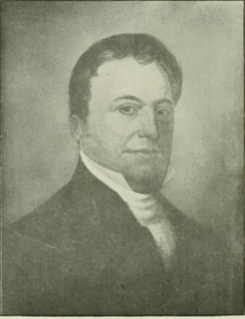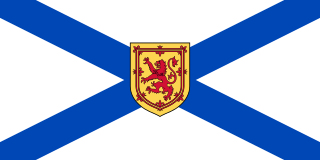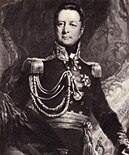
The Nova Scotia House of Assembly is one of two components of the General Assembly of Nova Scotia, the other being the Queen of Canada in Right of Nova Scotia represented by the Lieutenant Governor of Nova Scotia. It is the legislative branch of the provincial government of Nova Scotia, Canada. The assembly is the oldest in Canada, having first sat in 1758, and in 1848 was the site of the first responsible government in the British Empire.
The Executive Council of Nova Scotia is the cabinet of the Canadian province of Nova Scotia.

Each General Assembly of the legislature of the province of Nova Scotia, Canada, consists of one or more sessions and comes to an end upon dissolution and an ensuing general election. Today, the unicameral legislature is made up of two elements: the Lieutenant Governor and a legislative assembly called the House of Assembly. The legislature was first established in 1758.

Province House in Halifax is where the Nova Scotia legislative assembly, known officially as the Nova Scotia House of Assembly, has met every year since 1819, making it the longest serving legislative building in Canada. The building is Canada's oldest house of government. Standing three storeys tall, the structure is considered one of the finest examples of Palladian architecture in North America.
Argyle is a former provincial electoral district in Nova Scotia, Canada which existed between 1981-2013. It elected one member of the Nova Scotia House of Assembly. It was created in 1981 when the district of Yarmouth was split into two separate districts. In its last configuration, the district was composed of the Municipality of the District of Argyle, an Acadian area occupying the eastern half of Yarmouth County.
Nova Scotia is a parliamentary democracy. Its legislature consists of the Lieutenant Governor of Nova Scotia and fifty-one members representing their electoral districts in the Nova Scotia House of Assembly. As Canada's head of state, Queen Elizabeth II is the head of Nova Scotia's chief executive government. Her duties in Nova Scotia are carried out by the Lieutenant-Governor, Arthur LeBlanc. The government is headed by the Premier, Stephen McNeil, who took office October 22, 2013. Halifax is home to the House of Assembly and Lieutenant-Governor. The House of Assembly has met in Halifax at Province House since 1819.

Richard John Uniacke was a lawyer, judge and political figure in Nova Scotia. He represented Cape Breton County in the Nova Scotia House of Assembly from 1820 to 1830.
Joseph William Hadley was a merchant, ship's captain and political figure in Nova Scotia, Canada. He represented Guysborough County in the Nova Scotia House of Assembly from 1878 to 1882.
Charles James Campbell was a Scottish-born merchant and political figure in Nova Scotia, Canada. He represented Victoria in the House of Commons of Canada from 1874 to 1875, from 1876 to 1878 and from 1882 to 1887 as a Conservative member.

John Young was a Scottish-born merchant, author, agronomist, and agricultural reformer in Nova Scotia. He represented Sydney County in the Nova Scotia House of Assembly from 1824 to 1837. He supported the Royal Acadian School.
Benjamin DeWolf was a businessman and political figure in Nova Scotia. He represented Hants County in the Nova Scotia House of Assembly from 1783 to 1798.
William Browne Sargent was a fish merchant and political figure in Nova Scotia. He represented Barrington township in the Nova Scotia House of Assembly from 1818 to 1826.
Winthrop Sargent was a merchant and political figure in Nova Scotia. He represented Shelburne County in the Nova Scotia House of Assembly from 1836 to 1840.

Francis Joseph Rudolf was a judge and political figure in Nova Scotia. He represented Lunenburg County in the Nova Scotia House of Assembly from 1811 to 1820.
James Christian Bartling was a ship's captain, merchant and political figure in Nova Scotia, Canada. He was born in Port Mouton, Nova Scotia, the son of James Christian Bartling and Mary Irwin. He married Elizabeth McClearn.
Nathan Moses was a merchant and political figure in Nova Scotia. He represented Yarmouth township in the Nova Scotia House of Assembly from 1855 to 1859.
Felix Cochran was a political figure in Nova Scotia. He represented Newport township in the Nova Scotia House of Assembly from 1830 to 1836.
Donald Archie "Big Donnie" MacLeod was a Canadian politician. He represented the electoral district of Cape Breton West in the Nova Scotia House of Assembly from 1981 to 1988. He was a member of the Progressive Conservative Party of Nova Scotia.

The 41st Nova Scotia general election will be held when the provincial government passes "an Order in Council calling an election" to elect members to the Nova Scotia House of Assembly. Although the Nova Scotia Elections Act does not provide for fixed election dates, it is probable in 2021.







